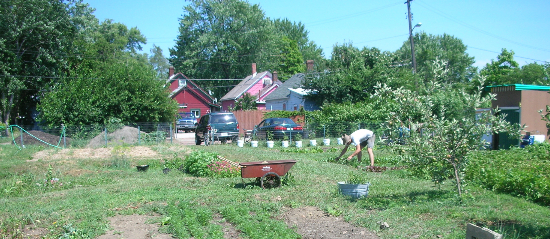
During a workshop for “Re-Imagining a More Sustainable Cleveland,” one of the attendees stated ardently that chickens and farms belong in the countryside, not in the city. I understand where he’s coming from.
It would be better to have farms in the land surrounding our cities instead of pavement and seemingly endless suburbia. But the fact of the matter is that we do have suburban sprawl, which directly influences the amount of land available for farming and the distance that food has to travel in order to get into our cities.
On top of that, many post-industrial cities like Cleveland are “food deserts.” Meaning, because of racism and white flight from the inner city, grocery stores abandoned the city to take up post in the more affluent suburban neighborhoods. In their place, fast food restaurants thrived because of the cheap price of processed foods. The consequence of this is that many inner city inhabitants suffer from health problems associated with their poor diets. But what alternatives do they really have?
The industrial farms that supply the processed food plants have put small farms out of business, resulting in the sale of that farmland to developers… continuing the downward spiral of suburban sprawl. And food has little flavor when it’s picked before it’s ripe so that it can look fine in a supermarket after being shipped long distances. No one benefits from this situation.
City Fresh, a non-profit program of the New Agrarian Center (NAC) shows us an alternative to this reality. City Fresh volunteers pick up fresh produce from local farms and bring them to the neighborhood food centers they’ve created around Northeast Ohio, improving access to fresh, locally grown food for urban residents and increasing marketing opportunities in the city for local farmers. In addition, City Fresh offers nutrition education, garden installations in urban areas, the cultivation of direct farm-to-business connections, and the City Fresh Youth program.
City Fresh’s model of improving access to fresh, local, and organic food for inner city residents demonstrates that there is, in fact, a market for this—and that our cities would benefit from having even more access to local food.
It’s no mystery that Cleveland is a shrinking city. Since the 1970 US Census, the region’s population has declined from 2.174 million people in 1970 to 1.987 million in 2008. Instead of crossing our fingers and hoping that more people all of a sudden decide to move back, we’re coming up with more productive uses of our underutilized land.
Urban farms are great uses for vacant land in our city because not only do they help improve access to local food for residents, but they also beautify the urban neighborhoods with green space. Urban farms also employ and educate locals about the benefits of local food and the business of agriculture. Many people benefit from this situation.
So, do chickens and farms have a place in the city? In ours, they do.
For more information about the benefits of the local food system in Northeast Ohio, I highly recommend that you watch the film Polycultures: Food Where We Live.
